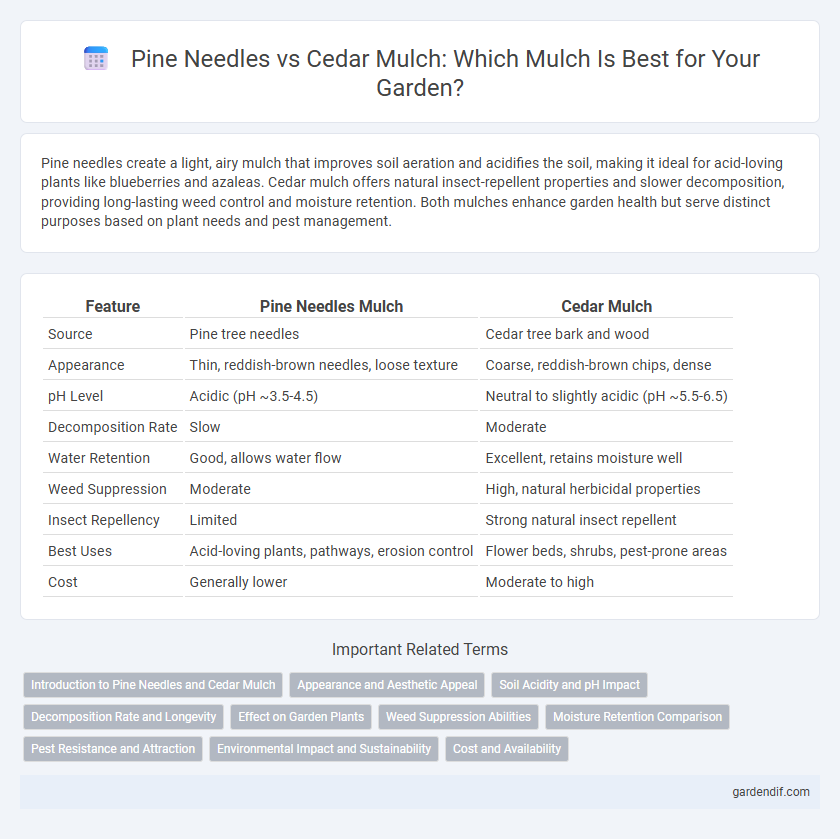
Pine needles vs cedar mulch Illustration
Pine needles create a light, airy mulch that improves soil aeration and acidifies the soil, making it ideal for acid-loving plants like blueberries and azaleas. Cedar mulch offers natural insect-repellent properties and slower decomposition, providing long-lasting weed control and moisture retention. Both mulches enhance garden health but serve distinct purposes based on plant needs and pest management.
Table of Comparison
| Feature | Pine Needles Mulch | Cedar Mulch |
|---|---|---|
| Source | Pine tree needles | Cedar tree bark and wood |
| Appearance | Thin, reddish-brown needles, loose texture | Coarse, reddish-brown chips, dense |
| pH Level | Acidic (pH ~3.5-4.5) | Neutral to slightly acidic (pH ~5.5-6.5) |
| Decomposition Rate | Slow | Moderate |
| Water Retention | Good, allows water flow | Excellent, retains moisture well |
| Weed Suppression | Moderate | High, natural herbicidal properties |
| Insect Repellency | Limited | Strong natural insect repellent |
| Best Uses | Acid-loving plants, pathways, erosion control | Flower beds, shrubs, pest-prone areas |
| Cost | Generally lower | Moderate to high |
Introduction to Pine Needles and Cedar Mulch
Pine needles mulch, known as pine straw, offers excellent aeration and water retention properties, making it ideal for acidic soil gardens and promoting healthy plant growth. Cedar mulch contains natural oils that repel insects and resist decay, providing long-lasting ground cover with a pleasant aroma. Both mulches enhance soil moisture retention and temperature regulation, but pine needles break down faster, enriching soil acidity, while cedar mulch provides superior weed control.
Appearance and Aesthetic Appeal
Pine needle mulch offers a fine, reddish-brown texture that creates a natural, rustic look, blending seamlessly with garden beds and evergreen landscapes. Cedar mulch features a rich, deep reddish color and a coarser, chunkier texture, adding a vibrant and polished appearance to flowerbeds and pathways. Both mulches enhance aesthetic appeal but cater to different style preferences, with pine needles providing a softer, subtler look and cedar mulch delivering a bold, decorative effect.
Soil Acidity and pH Impact
Pine needles create a more acidic soil environment with a pH ranging from 3.5 to 4.5, promoting nutrient availability for acid-loving plants like azaleas and blueberries. Cedar mulch tends to be less acidic, with a pH closer to neutral, making it suitable for a wider range of garden plants without significantly altering soil acidity. Using pine needles helps maintain lower soil pH levels, while cedar mulch supports moderate soil conditions for balanced plant growth.
Decomposition Rate and Longevity
Pine needle mulch decomposes slowly due to its tough, acidic composition, typically lasting up to two years before needing replacement. Cedar mulch boasts an even slower decomposition rate thanks to its natural oils that resist decay, providing longevity of three to five years. Both mulches improve soil acidity, but cedar offers extended durability and insect-repelling properties, making it a longer-lasting option.
Effect on Garden Plants
Pine needle mulch acidifies the soil, promoting growth for acid-loving plants such as azaleas and blueberries by lowering pH levels. Cedar mulch releases natural oils that deter pests but can slow the growth of sensitive garden plants due to allelopathic compounds. Understanding the specific needs of garden plants helps determine whether pine needles or cedar mulch will optimize soil conditions and plant health.
Weed Suppression Abilities
Pine needles mulch offers moderate weed suppression by creating a dense, acidic layer that inhibits weed seed germination and retains soil moisture effectively. Cedar mulch provides superior weed control due to its natural antimicrobial properties and slow decomposition, forming a thick barrier that blocks sunlight from reaching weed seeds. Both mulches improve soil health but cedar mulch generally outperforms pine needles in long-term weed suppression.
Moisture Retention Comparison
Pine needles mulch offers moderate moisture retention due to its airy texture, allowing some water to evaporate while still protecting soil moisture. Cedar mulch retains moisture more effectively because of its dense structure, reducing evaporation and maintaining consistent soil hydration. Both mulches improve soil moisture levels, but cedar mulch is superior for prolonged moisture conservation in gardens.
Pest Resistance and Attraction
Pine needles mulch offers excellent pest resistance due to its natural acidity, which repels insects like mosquitoes and ants, making it a preferred choice for gardens seeking low pest attraction. Cedar mulch contains natural oils and phenolic compounds that deter common pests such as termites, beetles, and fungus gnats, providing long-lasting protection for landscaped areas. Both mulches reduce pest populations effectively, but cedar mulch is typically more potent in repelling wood-boring insects, while pine needles excel in maintaining acidic soil conditions unfavorable to many garden pests.
Environmental Impact and Sustainability
Pine needles decompose slowly, enriching soil with acidic nutrients that support acid-loving plants, while cedar mulch contains natural oils that repel insects, potentially reducing the need for chemical pesticides. Both materials are renewable, but pine needles are often a byproduct of forestry operations, making them a sustainable choice with minimal waste. Cedar mulch's longer lifespan means less frequent replacement, which can lower resource consumption, though harvesting practices must ensure sustainable forestry to minimize environmental harm.
Cost and Availability
Pine needle mulch is generally more affordable and widely available, especially in regions with abundant pine forests, making it a cost-effective option for gardeners. Cedar mulch tends to be pricier due to limited supply and higher processing costs, but it offers longer-lasting durability. Availability of cedar mulch is more restricted, often found in specialized garden centers, while pine needle mulch is easier to source commercially and locally.
Pine needles vs cedar mulch Infographic

 gardendif.com
gardendif.com